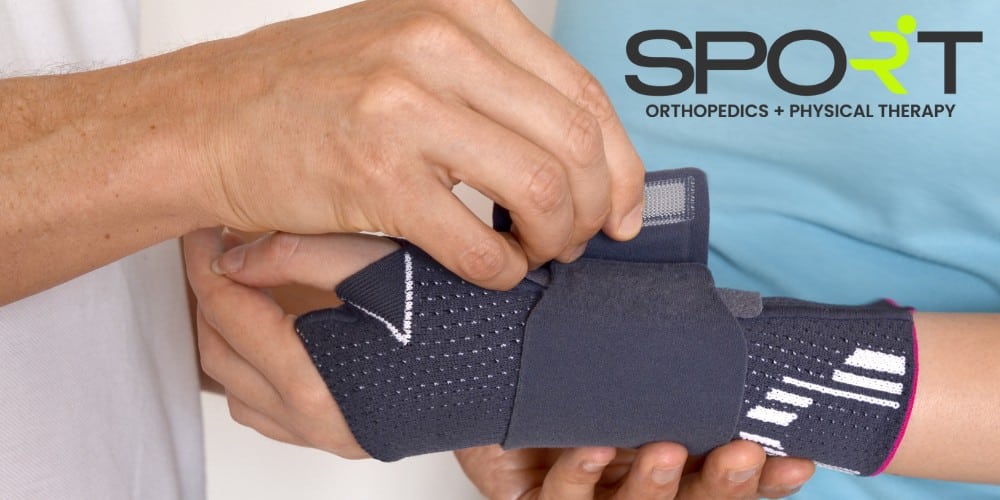An estimated 1 to 5% of the population currently suffers from carpal tunnel syndrome in the United States. Although this is a small percentage, it still translates into millions of people throughout the country. If you’re having symptoms of carpal tunnel syndrome, or if you’d like to try to prevent it, this blog outlines how to prevent carpal tunnel syndrome in several easy steps.
At SPORT Orthopedics + Physical Therapy, we have extensive experience treating carpal tunnel syndrome with both surgical and nonsurgical methods. We even have physical therapists who can work with you if you start to experience carpal tunnel syndrome symptoms. Our Dallas orthopedic specialists are here to ensure that your joints are in peak condition so that you don’t get sidelined by a serious injury or condition. To schedule an appointment with us, please call our office at 469-200-2832 today.
What Is Carpal Tunnel Syndrome?
Carpal tunnel syndrome is a condition in which there is pressure on the median nerve within the wrist. The carpal tunnel itself is a narrow passageway through which the median nerve runs. When the median nerve becomes compressed, this can lead to a number of problems in the hands and arms, including waking up with numb hands.
What Are the Symptoms of Carpal Tunnel?

The symptoms of carpal tunnel are fairly easy to identify, as they are very distinct. In the beginning stages of the condition, you may feel temporary numbness or tingling in your hands and wrists. Most people experience carpal tunnel symptoms in all of their fingers except the pinky. Some patients report feeling an electric shock sensation around the median nerve.
It is possible for the numbness and tingling to travel up your hands and wrists to your arms. Many people are even woken from sleep by the wrist pain caused by carpal tunnel syndrome. Symptoms tend to worsen while you use your hands for certain tasks, such as gripping a steering wheel or holding a cellphone.
Some people try to alleviate their symptoms by shaking out their hands and wrists periodically, but this is only a temporary fix. Over time, they may discover that this will have no effect on their symptoms. The condition can progress to the point where the numbness is constant.
Lastly, one of the most common CTS symptoms is weakness in the hand. You may be dropping objects more than you used to, or you might feel that you have a loose grip when you try to pinch something with your thumb and fingers.
What Causes Carpal Tunnel?
One of the first steps in preventing carpal tunnel syndrome is to understand what can cause it in the first place. The general cause of carpal tunnel is pressure placed on the median nerve. But how does this pressure happen? When an object or motion irritates or squeezes the median nerve, this can eventually cause carpal tunnel syndrome. One example of how this can occur is through repetitive motions with the hands and wrists, such as typing on a keyboard or using a computer mouse frequently.
Wrist fractures can also increase one’s risk of carpal tunnel. When someone breaks their wrist, this can cause the carpal tunnel to become narrower. Having a narrow carpal tunnel increases the risk of putting pressure on the median nerve. Swelling and inflammation that result from rheumatoid arthritis can also cause the carpal tunnel to narrow.
Risk Factors for Carpal Tunnel Syndrome

In many cases, wrist compression is not the only risk factor when it comes to developing carpal tunnel. Other factors can contribute to the development of carpal tunnel, even if they don’t directly cause the condition. The following risk factors may increase one’s risk of compressing nerves in the carpal tunnel.
- Anatomy: As we stated previously, fractured or dislocated wrists can cause the carpal tunnel to become narrower. This makes compression of the median nerve more likely. The same can be said for those who have naturally narrower carpal tunnels.
- Gender: Typically, carpal tunnel is more common in women than in men. This is likely due to the fact that women tend to have smaller carpal tunnel spaces than men.
- Work-related causes: If you frequently work with tools that vibrate, or if you use a repetitive motion for work, this can apply pressure to the median nerve. You may also feel symptoms of carpal tunnel if you work an office job that requires frequent use of a mouse and keyboard.
- Certain medical conditions: Conditions other than carpal tunnel can cause symptoms that put pressure on the median nerve. Examples of these conditions include rheumatoid arthritis, diabetes, nerve damage, menopause, thyroid disorders, and other medical conditions.
How Can I Avoid Carpal Tunnel Syndrome?
In order to effectively prevent carpal tunnel syndrome or to mitigate your existing symptoms, you’ll need to be proactive. Certain lifestyle changes may be necessary in order to keep your median nerve functioning properly. Keep in mind that, even if you are diligent about carpal tunnel treatment and prevention, you may still experience symptoms. However, the following changes can help you minimize stress on your hands and wrists.
- If your job requires you to execute repetitive tasks with your hands or wrists, try to do these things more gently. For example, if you type with a keyboard all day, try tapping the keys softly. If you need to write with a pen or pencil for long periods, consider getting a soft grip adapter to reduce the strain on your joint.
- Take frequent breaks, especially from repetitive tasks. At least once an hour, try to gently stretch your wrists, hands, and fingers. You can also alternate tasks to avoid doing the same motions for too long.
- Ensure that you keep your wrists at a relaxed middle position. Raise or lower your keyboard so that it either sits level with your elbow, or slightly lower. Avoid bending your wrists too much and maintain the proper posture while you work.
- Even your overall posture can affect your wrists and hands. If you have poor posture, your neck and shoulder muscles could shorten and eventually compress the nerves in your neck. This can then affect your wrists. Avoid rolling your shoulders forward, and instead sit up straight.
- Many people who work in cold office buildings find that keeping their wrists warm helps to alleviate their symptoms. If you can’t increase the temperature, consider wearing gloves to keep your wrists and hands warm.
How to Prevent Carpal Tunnel with Exercise

You can also practice certain hand and wrist exercises in order to keep your joints strong and mobile. Below, we outline some of our favorite carpal tunnel exercises.
Prayer Stretch
Start in a neutral position, with your palms pressed together in front of your chest, just below your chin. While keeping your palms together, lower your hands toward your stomach until you feel a stretch in your forearm. Hold this position for around 30 seconds, then return to the neutral position. Repeat this process up to four times.
Wrist Flexor Stretch
Hold the affected arm out in front of you with your palm facing upward. Using your free hand, bend your wrist and point your fingers toward the floor. Do this until you feel a stretch in your forearm. Hold this position for around 30 seconds, then return to the starting position. Repeat this process up to four times.
Wrist Extensor Stretch
Repeat all of the steps for the wrist flexor stretch, except rotate the affected arm so that the palm faces the floor.
Carpal Tunnel Treatments

If you still develop hand pain or symptoms after taking preventative measures, it may be time to see a physical or occupational therapist. You may even need to wear a wrist brace while you sleep to avoid bending it and compressing the median nerve. If you receive an early diagnosis, you may be able to avoid surgical treatments. However, waiting too long could leave surgery as the only option.
Below, we list some of the most common treatments for carpal tunnel syndrome.
- Applying cold packs to reduce swelling
- Wrist splints
- Non-steroidal anti-inflammatory drugs (NSAIDs)
- Corticosteroid injections
- Endoscopic carpal tunnel release
- Open wrist surgery
Contact SPORT Orthopedics + Physical Therapy Today
If you’re suffering from recurrent carpal tunnel pain and discomfort, the Dallas orthopedic surgeons at SPORT Orthopedics + Physical Therapy are here for you. We are dedicated to ensuring that our patients receive only the best in orthopedic care. We will evaluate your symptoms, identify the source of your pain, and develop a personalized treatment plan that works for you. To schedule an appointment with us, please call our office at 469-200-2832 today.



